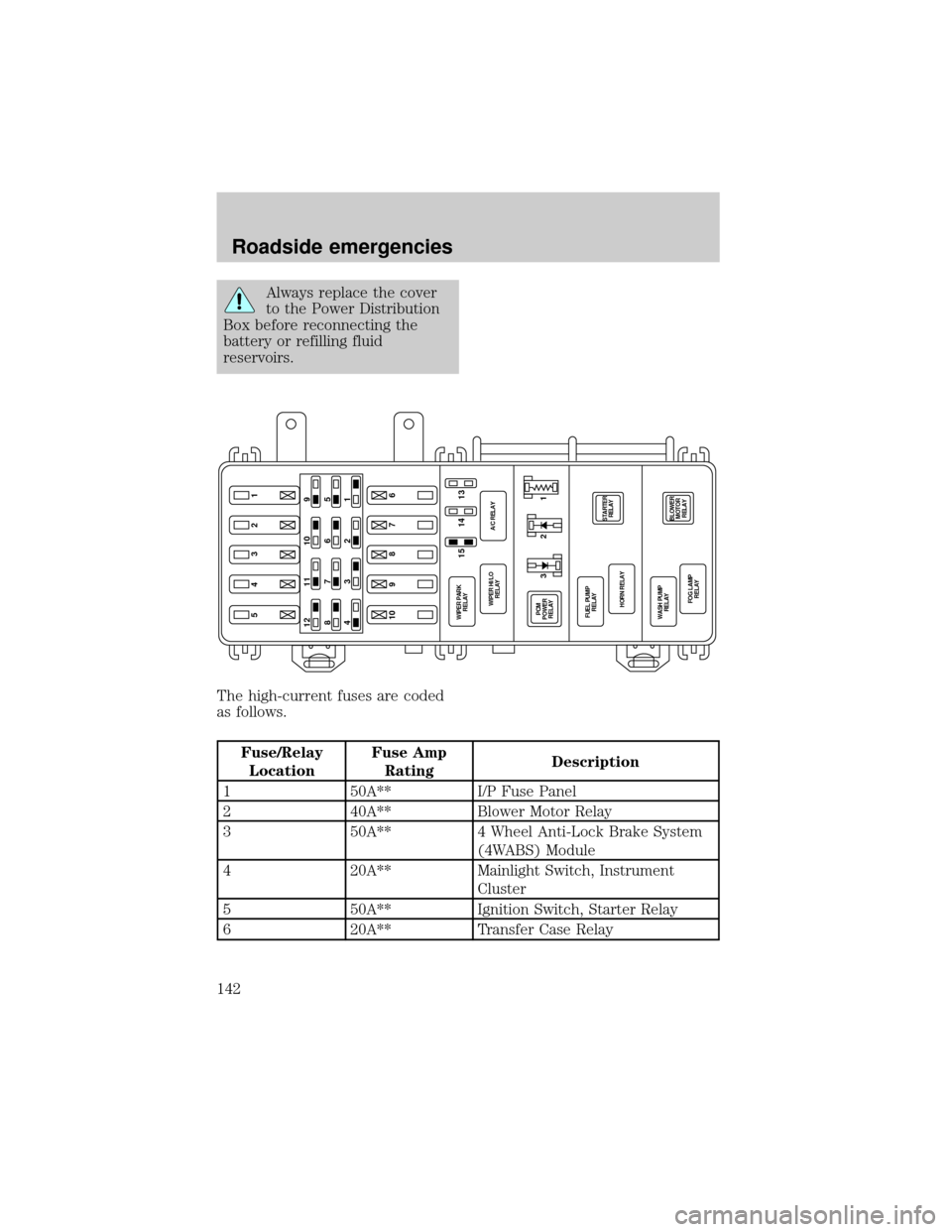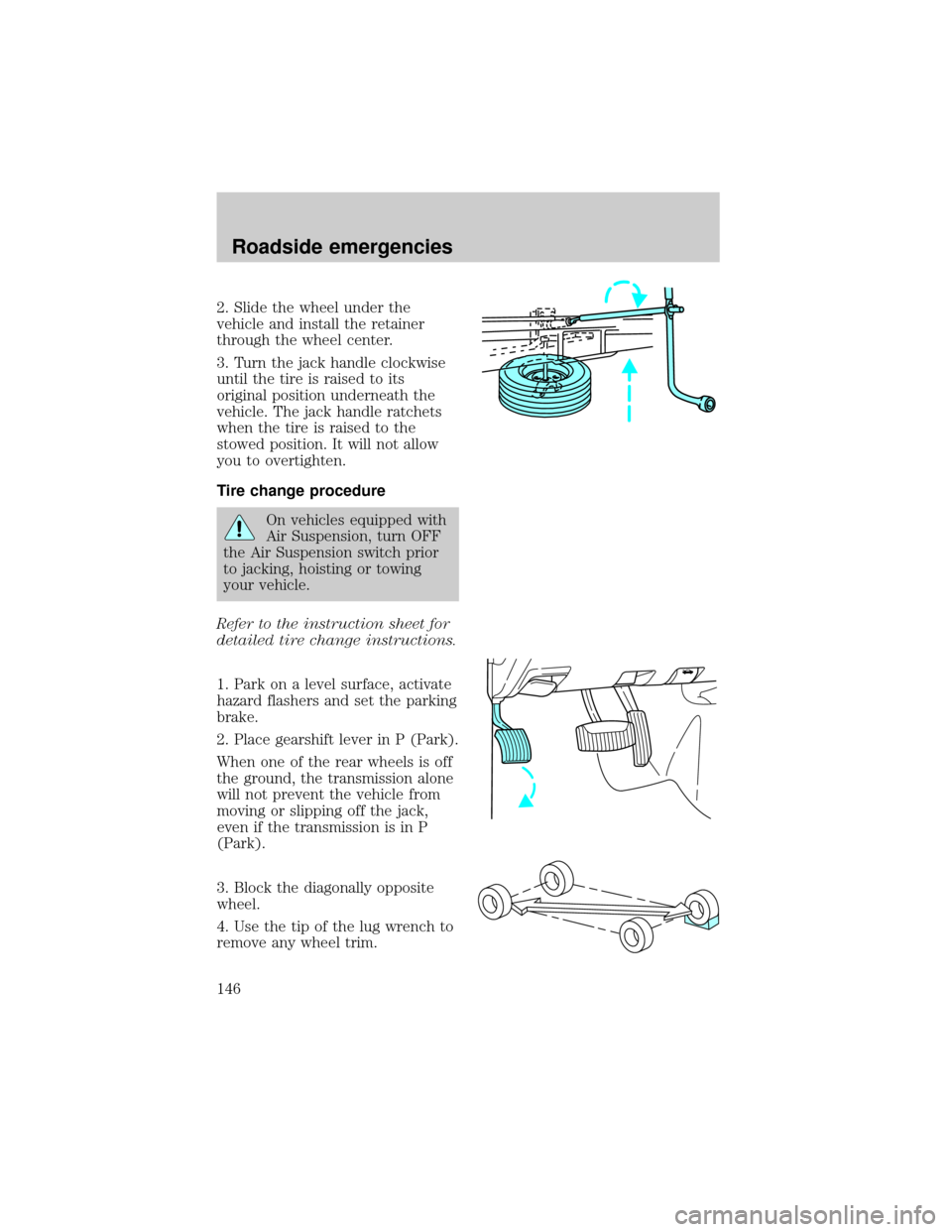lock Mercury Mountaineer 1998 s Service Manual
[x] Cancel search | Manufacturer: MERCURY, Model Year: 1998, Model line: Mountaineer, Model: Mercury Mountaineer 1998Pages: 216, PDF Size: 1.72 MB
Page 118 of 216

Avoid sudden applications of
power and quick changes of
direction on snow and ice. Apply
the accelerator slowly and steadily
when starting from a full stop.
When braking, apply the brakes as
you normally would. In order to
allow the anti-lock brake system
(ABS) to operate properly, keep
steady pressure on the brake
pedal.
Allow more stopping distance and
drive slower than usual. Consider
using one of the lower gears.
ALL WHEEL DRIVE (AWD)
SYSTEM (IF EQUIPPED)
(5.0L ENGINES ONLY)
Your vehicle is equipped with a
full-time All Wheel Drive (AWD)
transfer case. Power is supplied to
all four wheels all the time with no
need to shift between two-wheel
drive and four-wheel drive.
For the lubricant specification and
refill capacity of the AWD transfer
case refer toCapacities and
specificationschapter.
Utility and four-wheel
drive vehicles arenot
designed for cornering at speeds
as high as passenger cars any
more than low-slung sports cars
are designed to perform
satisfactorily under off-road
conditions. Avoid sharp turns or
abrupt maneuvers in these
vehicles.
Driving
118
Page 122 of 216

When speed control is on and you
are driving uphill, your vehicle
speed may drop considerably,
especially if you are carrying a
heavy load.
If vehicle speed drops more than
16 km/h (10 mph), the speed
control will cancel automatically.
Resume speed with accelerator
pedal.
If speed control cancels after
climbing the hill, reset speed by
pressing and holding the SET
ACCEL button (to resume speeds
over 50 km/h (30 mph).
Automatic transmissions may shift
frequently while driving up steep
grades. Eliminate frequent shifting
by shifting out of
(Overdrive)
into D (Drive).
Driving on snow and ice
An AWD vehicle has advantages
over 2WD vehicles in snow and ice
but can skid like any other vehicle.
Avoid sudden applications of
power and quick changes of
direction on snow and ice. Apply
the accelerator slowly and steadily
when starting from a full stop.
When braking, apply the brakes as
you normally would. In order to
allow the anti-lock brake system
(ABS) to operate properly, keep
steady pressure on the brake
pedal.
Allow more stopping distance and
drive slower than usual. Consider
using one of the lower gears.
Driving
122
Page 134 of 216

To adjust cross-bar position:
1. Slide the locking switches at
each end of the crossbar toward
the rear of the vehicle until
UNLOCKED appears.
2. Slide cross-bar to the desired
location.
3. Lock the cross-bar into position
by pushing the locking switches on
each end of the crossbar toward
the front of the vehicle.
The rear rack can be completely
removed in the UNLOCKED
position by sliding the cross-bar
rearward until it frees the guides.
FUEL CONSUMPTION
Fuel economy can be improved by
avoiding:
²lack of regular, scheduled
maintenance
²excessive speed
²rapid acceleration
²extended idle
Driving
134
Page 139 of 216

The fuses are coded as follows.
Fuse/Relay
LocationFuse Amp
RatingDescription
1 7.5A Power Mirror Switch
2 7.5A Blower Motor Relay, PAD Module,
Air Bag Diagnostic Monitor
3 7.5A Trailer Tow Connector
4 10A Left Headlamp
5 10A Data Link Connector (DLC)
6 7.5A Air Bag Diagnostic Monitor,
Blower Motor Relay, Passive
Deactivation (PAD) Module
7 7.5A Trailer Tow Connector
8 10A Right Headlamp, Daytime Running
Lamps (DRL) Module, Foglamp
Relay
9 7.5A Stop Lamp Switch
10 7.5A Speed Control/Amplifier Assembly,
Brake Pressure Switch, Generic
electronic Module (GEM), Shift
Lock Actuator, Blend Door
Actuator, Main Light Switch,
RABS Resistor, A/C - Heater
Assembly, Flasher
11 7.5A Instrument Cluster, Main Light
Switch, RABS Resistor
12 10A Power Window Relay, Washer
Pump Relay
13 20A Stop Lamp Switch, Brake
Pressure Switch
14 20A Rear Anti-Lock Brake System
(RABS) Module
Roadside emergencies
139
Page 140 of 216

Fuse/Relay
LocationFuse Amp
RatingDescription
14 10A 4 Wheel Anti-Lock Brake System
(4WABS) Module, 4WABS Main
Relay
15 7.5A Instrument Cluster
16 30A Windshield Wiper Motor, Wiper
Hi-Lo Relay, Wiper Run/Park
Relay
17 7.5A Cigar Lighter
18 15A Drivers Unlock Relay, All unlock
Relay, All Lock Relay
19 25A PCM Power Diode
20 7.5A RAP Module, Generic Electronic
Module (GEM), Radio
21 15A Flasher (Hazard)
22 20A Auxiliary Power Socket
23 15A Turn Signals
24 - Not Used
25 7.5A Generic Electronic Module
(GEM), Instrument Cluster
26 10A Battery Saver Relay, Electronic
Shift Relay, Interior Lamp Relay,
Power Window Relay, Electronic
Shift Control Module,
Transmission Control
27 15A Switch, DRL, Backup Lamps
Switch, DTR Sensor, Instrument
Illumination Dimming Module,
Dome/Map Lamp, GEM, Electric
Shift, Interior Lights, Glove Box
Lamp and Switch
28 7.5A Generic Electronic Module
(GEM), Radio
29 15A Radio
Roadside emergencies
140
Page 142 of 216

Always replace the cover
to the Power Distribution
Box before reconnecting the
battery or refilling fluid
reservoirs.
The high-current fuses are coded
as follows.
Fuse/Relay
LocationFuse Amp
RatingDescription
1 50A** I/P Fuse Panel
2 40A** Blower Motor Relay
3 50A** 4 Wheel Anti-Lock Brake System
(4WABS) Module
4 20A** Mainlight Switch, Instrument
Cluster
5 50A** Ignition Switch, Starter Relay
6 20A** Transfer Case Relay
5432110 9 8 7 612 11 10 9
876 5
432 1
14 15 13
BLOWER
MOTOR
RELAYSTARTER
RELAY
FOG LAMP
RELAY WASH PUMP
RELAYHORN RELAY FUEL PUMP
RELAY PCM
POWER
RELAY WIPER PARK
RELAY
WIPER HI/LO
RELAYA/C RELAY
321
Roadside emergencies
142
Page 143 of 216

Fuse/Relay
LocationFuse Amp
RatingDescription
7 Ð NOT USED
8 20A** Automatic Ride Control ARC
Switch Off/On Switch
9 40A** Automatic Ride Control Relay
10 30A** PCM Power Relay
1 10A* A/C Relay
2 20A* Auxiliary Power Point
3 ± Not Used
4 15A* Fog Lamps and Daytime Running
Lamps
5 10A* Air Bag Diagnostic Monitor
6 10A* Powertrain Control Module
7 30A* 4 Wheel Anti-Lock System
(4WABS) Module
8 30A* PCM Relay
9 20A* Fuel Pump Relay and RAP
Module
10 15A* Horn Relay
11 15A* Parklamps Relay and Mainlight
Switch
12 30A* Mainlight Switch and
Multifunction Switch
13 15A* Heated Oxygen Sensor, EGR
Vacuum Regulator, EVR Solenoid,
Camshaft Position (CMP) Sensor,
Canister Vent Solenoid, A4LD
Automatic Transmission
14 30A* Generator/Voltage Regulator
Wiper Park Relay Ð Wiper Park Relay
Wiper HI/LO
RelayÐ Wiper HI/LO Relay
Roadside emergencies
143
Page 144 of 216

Fuse/Relay
LocationFuse Amp
RatingDescription
PCM Power
RelayÐ PCM Power Relay
Fuel Pump Relay Ð Fuel Pump Relay
Horn Relay Ð Horn Relay
Washer Pump
RelayÐ Washer Pump Relay
Fog Lamp Relay Ð Fog Lamp Relay
Starter Relay Ð Starter Relay
Blower Motor
RelayÐ Blower Motor Relay
1 Resistor Fuse [7ca]
2 Diode Anti-Lock Brakes Indicator
3 Diode Electronic Engine Controls
* Mini Fuses ** Maxi Fuses
15.0L Engines Only
CHANGING THE TIRES
If you get a flat tire while driving,
do not apply the brake heavily.
Instead, gradually decrease your
speed. Hold the steering wheel
firmly and slowly move to a safe
place on the side of the road.
Spare tire information
Your vehicle is equipped with a
spare tire that may be used as a
spare or a regular tire. The spare
tire is not equipped with wheel
trim. The wheel trim from the
original wheel/tire may be used on
the spare.
If your vehicle is equipped with
4WD or AWD, a spare tire of a
different size than the road
tires should not be used. Such
Roadside emergencies
144
Page 145 of 216

a tire could result in damage to
driveline components and make
the vehicle difficult to control.
Location of the spare tire and
tools
The spare tire and tools for your
vehicle are stowed in the following
locations:
Tool Location
Spare tire Under the vehicle, just in front of
the rear bumper
Jack, lug nut wrench Left rear quarter panel behind
interior trim
Jack handle Behind rear seats, under carpet
Removing the spare tire
1. Insert the jack handle into the
rear bumper opening.
The handle will stop moving and
forward resistance to turning will
be felt when properly engaged.
2. Turn the handle
counterclockwise until tire is
lowered to the ground, the tire can
be slid rearward and the cable is
slightly slack.
3. Remove the retainer from the
spare tire.
Stowing the spare
1. Lay the tire on the ground with
the valve stem facing up.
Roadside emergencies
145
Page 146 of 216

2. Slide the wheel under the
vehicle and install the retainer
through the wheel center.
3. Turn the jack handle clockwise
until the tire is raised to its
original position underneath the
vehicle. The jack handle ratchets
when the tire is raised to the
stowed position. It will not allow
you to overtighten.
Tire change procedure
On vehicles equipped with
Air Suspension, turn OFF
the Air Suspension switch prior
to jacking, hoisting or towing
your vehicle.
Refer to the instruction sheet for
detailed tire change instructions.
1. Park on a level surface, activate
hazard flashers and set the parking
brake.
2. Place gearshift lever in P (Park).
When one of the rear wheels is off
the ground, the transmission alone
will not prevent the vehicle from
moving or slipping off the jack,
even if the transmission is in P
(Park).
3. Block the diagonally opposite
wheel.
4. Use the tip of the lug wrench to
remove any wheel trim.
Roadside emergencies
146